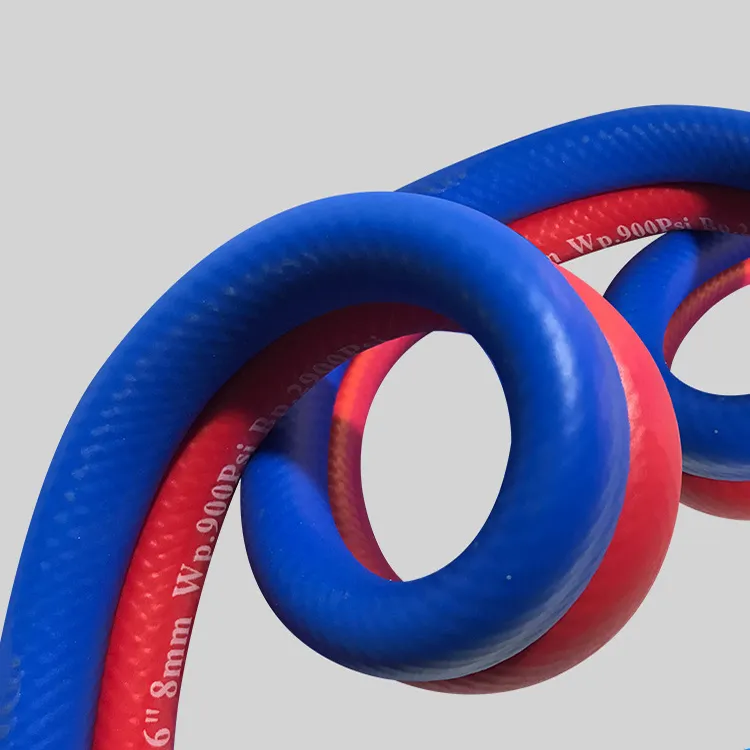oxy acetylene welding hose
Understanding Oxy-Acetylene Welding Hoses Essential Equipment for Welders
Oxy-acetylene welding is a widely used technique that combines oxygen and acetylene gas to produce a flame capable of melting metals. This method is highly valued in metal fabrication, automotive repair, and artistic welding, owing to its versatility and effectiveness. At the heart of this process lies a critical component the oxy-acetylene welding hose. This article will explore the characteristics, types, and maintenance considerations of these hoses, underlining their importance in achieving successful welding outcomes.
What is an Oxy-Acetylene Welding Hose?
Oxy-acetylene welding hoses are specialized tubes designed to transport oxygen and acetylene from the tanks to the torch. They are engineered to handle high pressure and temperature, ensuring safety and reliability during the welding process. Typically, these hoses are color-coded for easy identification the oxygen hose is often green, while the acetylene hose is red. This differentiation is crucial not only for safety reasons but also for ensuring proper connections during setup.
Key Characteristics of Oxy-Acetylene Welding Hoses
1. Material Construction Oxy-acetylene hoses are usually made from a synthetic rubber or thermoplastic material reinforced with a textile or fiber braid. This construction provides flexibility while maintaining resistance to heat, abrasions, and kinks, which can impede the flow of gases and affect welding performance.
2. Pressure Ratings The hoses are built to withstand specific pressures the oxygen hose generally has a higher working pressure than the acetylene hose. Understanding these ratings is paramount; using a hose that does not meet the pressure requirements can lead to dangerous leaks or burst hoses.
3. Diameter The diameter of the hoses influences the volume of gas that can flow through them. Standard sizes include 1/4 inch and 5/16 inch, but the choice of diameter may depend on the application and the size of the torch being used.
4. Length Oxy-acetylene hoses are available in various lengths. It's essential to select a length that allows for comfortable maneuverability while avoiding excessive slack that could lead to tripping hazards.
Types of Oxy-Acetylene Welding Hoses
Welding hoses can be categorized based on their operational specifics
1. Standard Hoses Most commonly used by welders, these hoses are suitable for general welding applications and are designed to meet the basic requirements for pressure and durability.
oxy acetylene welding hose

2. High-Pressure Hoses For more demanding applications, high-pressure hoses are designed to withstand greater stress. They are typically used in industrial or heavy-duty environments where higher productivity is necessary.
3. Specialty Hoses Some hoses are engineered for specific purposes, such as those designed for use in extreme temperatures or with certain chemical exposures. Welders working in unique environments may require these specialized hoses for optimal performance and safety.
Maintenance and Safety Considerations
Proper maintenance of oxy-acetylene hoses is crucial for ensuring both longevity and safety. Here are some essential tips
1. Regular Inspection Always inspect hoses for signs of wear, cracks, or leaks before each use. Any defective hose should be replaced immediately to prevent dangerous accidents.
2. Storage Hoses should be stored properly when not in use. Avoid coiling them too tightly, as this can cause internal damage. Instead, use hose reels or hang them loosely to maintain their integrity.
3. Avoid Overexposure Keep hoses away from excessive heat sources, sharp edges, or harsh chemicals that could degrade their material.
4. Connection Check Ensure that all connections are secure and leak-free before igniting the torch. A simple soap solution can be used to check for leaks around fittings.
5. Regulatory Compliance Adhere to local safety regulations regarding the handling and storage of oxygen and acetylene gases to mitigate risks while welding.
Conclusion
Oxy-acetylene welding hoses are indispensable tools for welders, enabling them to perform intricate tasks with precision and safety. Understanding the characteristics, types, and maintenance practices of these hoses is crucial for anyone serious about welding. By taking proper care of this equipment, welders can ensure successful projects while prioritizing safety in their work environment. Investing time in learning about and maintaining oxy-acetylene hoses will ultimately lead to enhanced performance and superior results in welding tasks.
-
Top Quality Oxy Acetylene Hoses for Sale Fit for Welding DemandsNewsJul.28,2025
-
The Future of Pneumatic Air Tubes in IndustryNewsJul.28,2025
-
Superior and Reliable LPG Hose Pipe Solutions for Every NeedNewsJul.28,2025
-
Exceptionally Durable and Versatile Premium Braided PVC TubingNewsJul.28,2025
-
Best Adapters for Connecting Garden Hose to PVC Pipe ConnectionsNewsJul.28,2025
-
The Essential Role of LPG Hoses in Safe and Efficient Gas DistributionNewsJul.16,2025














